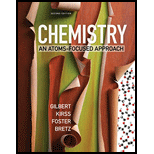
To calculate:
a. The amount of
b. The amount of zinc which is required to convert
c. The volume of gold block in
Answer to Problem 7.91QA
Solution:
a. The amount of
b. The amount of zinc which is required to convert
c. The volume of gold block in
Explanation of Solution
1) Concept:
The overall process describes the extraction of gold from the rock using
The process occurs in two steps:
Both these reactions are balanced.
In a balanced chemical equation, if we know the amount of reactant, the amount of product can be calculated using stoichiometry of the reactions mentioned above.
2) Formula:
i)
ii)
3) Given:
The two steps involved to extract gold from the rock:
i)
ii)
iii) The mass of rock =
iv) The density of gold =
v) Mass % for gold =
4) Calculation:
a. Mass of rock
Mass percent of gold
Mass of gold extracted
Number of moles of Au is calculated as:
From the first given equation, the mole ratio of
Moles of
Converting mol of
b. The balanced chemical equation (for 1st step) is:
Mole ratio of
So, the number of moles of
The balanced chemical equation (for 2nd step) is:
Mole ratio of
So, the number of moles of Zn is calculated as:
Converting
c. The mass of gold extracted =
The density of gold =
Volume of gold ingot is calculates as:
All the quantitative information about the products can be obtained from the balanced equation.
Want to see more full solutions like this?
Chapter 7 Solutions
Chemistry: An Atoms-Focused Approach (Second Edition)
- V Biological Macromolecules Drawing the Haworth projection of an aldose from its Fischer projection Draw a Haworth projection of a common cyclic form of this monosaccharide: H C=O HO H HO H H OH CH₂OH Explanation Check Click and drag to start drawing a structure. Xarrow_forwardComplete the mechanismarrow_forwardComplete the mechanismarrow_forward
- 8 00 6 = 10 10 Decide whether each of the molecules in the table below is stable, in the exact form in which it is drawn, at pH = 11. If you decide at least one molecule is not stable, then redraw one of the unstable molecules in its stable form below the table. (If more than unstable, you can pick any of them to redraw.) Check OH stable HO stable Ounstable unstable O OH stable unstable OH 80 F6 F5 stable Ounstable X Save For Later Sub 2025 McGraw Hill LLC. All Rights Reserved. Terms of Use | Privacy C ཀྭ་ A F7 매 F8 F9 4 F10arrow_forwardJust try completing it and it should be straightforward according to the professor and TAs.arrow_forwardThe grading is not on correctness, so if you can just get to the correct answers without perfectionism that would be great. They care about the steps and reasoning and that you did something. I asked for an extension, but was denied the extension.arrow_forward
 ChemistryChemistryISBN:9781305957404Author:Steven S. Zumdahl, Susan A. Zumdahl, Donald J. DeCostePublisher:Cengage Learning
ChemistryChemistryISBN:9781305957404Author:Steven S. Zumdahl, Susan A. Zumdahl, Donald J. DeCostePublisher:Cengage Learning ChemistryChemistryISBN:9781259911156Author:Raymond Chang Dr., Jason Overby ProfessorPublisher:McGraw-Hill Education
ChemistryChemistryISBN:9781259911156Author:Raymond Chang Dr., Jason Overby ProfessorPublisher:McGraw-Hill Education Principles of Instrumental AnalysisChemistryISBN:9781305577213Author:Douglas A. Skoog, F. James Holler, Stanley R. CrouchPublisher:Cengage Learning
Principles of Instrumental AnalysisChemistryISBN:9781305577213Author:Douglas A. Skoog, F. James Holler, Stanley R. CrouchPublisher:Cengage Learning Organic ChemistryChemistryISBN:9780078021558Author:Janice Gorzynski Smith Dr.Publisher:McGraw-Hill Education
Organic ChemistryChemistryISBN:9780078021558Author:Janice Gorzynski Smith Dr.Publisher:McGraw-Hill Education Chemistry: Principles and ReactionsChemistryISBN:9781305079373Author:William L. Masterton, Cecile N. HurleyPublisher:Cengage Learning
Chemistry: Principles and ReactionsChemistryISBN:9781305079373Author:William L. Masterton, Cecile N. HurleyPublisher:Cengage Learning Elementary Principles of Chemical Processes, Bind...ChemistryISBN:9781118431221Author:Richard M. Felder, Ronald W. Rousseau, Lisa G. BullardPublisher:WILEY
Elementary Principles of Chemical Processes, Bind...ChemistryISBN:9781118431221Author:Richard M. Felder, Ronald W. Rousseau, Lisa G. BullardPublisher:WILEY





